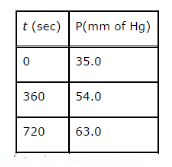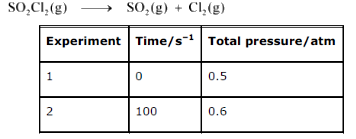Complete Solutions to NCERT EXERCISES of chapter CHEMICAL KINETICS of Class 12 book with complete answers and questions
| Class 12 | CHEMISTRY |
| Chapter | CHEMICAL KINETICS |
| PRADEEP | NCERT EXERCISES |
| Number Of Questions | 30 |
| Academic Year | 2023-24 |
From the rate expression for the following reactions, determine their order of reaction and dimensions of the rate constants.
`a. 3NO(g) rarr N_(2)O(g),` Rate`=k[NO]^(2)`
`b. H_(2)O_(2)(aq)+3I^(c-)(aq)+2H^(o+) rarr 2H_(2)O(l)+I_(3)^(c-),` Rate`=k[H_(2)O_(2)][I^(c-)]`
`c. CH_(3)CHO(g)rarr CH_(4)(g)+CO(g),` Rate`=k[CH_(3)CHO]^(3//2)`
`d. C_(2)H_(5)Cl(g) rarr C_(2)H_(4)(g)+HCl(g),` Rate `k[C_(2)H_(5)Cl]`
View SolutionFor the reaction `:`
`2A+B rarr A_(2)B`
the rate `=k[A][B]^(2)` with `k=2.0xx10^(-6)mol^(-2)L^(2)s^(-1)`. Calculate the initial rate of the reaction when `[A]=0.1 mol L^(c-),[B]=0.2 mol L^(-1)`. Calculate the rate of reaction after `[A]` is reduced to `0.06 mol L^(-1)`.
View SolutionThe decomposition of `NH_(3)` on platinum surface is zero order reaction. What are the rates of production of `N_(2)` and `H_(2)` if `k=2.5xx10^(-4)mol^(-1)"L s"^(-1)` ?
View SolutionThe decomposition of dimethyl ether leads to the formation of `CH_(4),H_(2),` and `CO` and the reaction rate is given by
Rate `=k[CH_(3)OCH_(3)]^(3//2)`
The rate of reaction is followed by increase in the pressure in a closed vessel , so the rate can also be expressed in terms of the partial pressure of dimethyl either, `i.e., `
Rate `=k[p_(CH_(3)OCH_(3))]^(3//2)`
If the pressure is measured in bar and time in minutes, then what are the units of rate and rate constant ?
View SolutionMention the factors that affect the rate of a chemical reaction.
View SolutionA reaction is second order with respect to a reactant. How is the rate of reaction affected if the concentration of the reactant is (i) doubled (ii) reduced to `1//2` ?
View SolutionWhat is the effect of temperature on the rate constant of reaction? How can this temperature effect on the rate constant be represented quantitatively?
View SolutionIn a pseudo first order hydrolysis of ester in water the following result6s were obtained:
`{:(t//s,0,30,60,90),(["Ester"],0.55,0.31,0.17,0.085):}`
(i) Calculate the average rate of reaction between the time interval `30` to `60` seconds.
(ii) Calculate the pseudo first order rate constant for the hydrolysis of ester.
View SolutionA reaction is first order in A and second order in B
(i) Write the differential rate equation.
(ii) How is the rate affected on increasing the concentation of B three times ?
(iii) How is the rate affected when the concentration of both A and B are doubled ?
View SolutionIn a reaction between A and B, the initial rate of reaction was measured for different initial concentration of A and B as given below:
`{:(A//M,0.20,,0.20,0.40),(B//M,0.30,,0.10,0.05),(r_(0)//M s^(-1),5.07xx10^(-5),,5.07xx10^(-5),7.6xx10^(-5)):}`
View SolutionThe following rate data were obtained at 303K for the following reaction :
`2A+BtoC+D`
`{:("Experiment",,,[A]//"mol "L^(-1),,,[B]//"mol "L^(-1),,,"Initial rate of formation of "D//"mol "L^(-1)min^(-1)),(I,,,0*1,,,0*1,,,6*0xx10^(-3)),(II,,,0*3,,,0*2,,,7*2xx10^(-2)),(III,,,0*3,,,0*4,,,2*88xx10^(-1)),(IV,,,0*4,,,0*1,,,2*4xx10^(-2)):}`
What is the rate law ? What is the order with respect to each reactant and the overall order ? Also calculate the rate constant and write its units.
View SolutionThe reaction between A and B is first order with respect to A and zero with respect to B. Fill in tha blanks in the following table:
`{:("Experiment",,[A]//M,[B]//M,"Initial rate"//"M min"),(I.,,0.1,0.1,2.0xx10^(-2)),(II.,,....,0.2,4.0xx10^(-2)),(II.,,0.4,0.4,.......),(IV.,,....,0.2,2.0xx10^(-2)):}`
View SolutionCalculate the half life of a first order reaction from their rate constants given below :
(a) `200" s"^(-1)` (b) `2" min"^(-1)` ( c ) `4" year"^(-1)`
View SolutionThe half-life for radioactive decay of `""^(14)C` is 5730 y.
An archaelogical artifact contained wood that had
only `80%` of the `""^(14)C` found in living tree.
Estimate the age of the sample.
View SolutionThe experimental data for the decomposition of `N_(2)O_(5)[2N_(2)O_(5)to4NO_(2)+O_(2)]` in gas phase at 318 K are given below :
`{(t//s,,0,,400,,800,,1200,,1600,,2000,,2400,,2800,,3200),(10^(2)xx[N_(2)O_(5)]//molL^(-1),,1*63,,1*36,,1*14,,0*93,,0*78,,0*64,,0*53,,0*43,,0*35):}`
(i) Plot "[N_(2)O_(5)]" against time.",,,,"
(ii) Find the half-life period for the reaction.")
("(iii) Draw a graph between "log[N_(2)O_(5)]" and t.",,,,"
(iv) What is rate law ?"
(v) Calculate the rate constant.
(vi) Calculate the half-life period from k and compare it with (ii).
View SolutionThe rate constant for a first order reaction is `60s^(-1)`. How much time will it take to reduce the initial concentrationof the reactant to its `1//16th` value ?
View SolutionDuring nuclear explosion, one of the products is `.^(90)Sr` with half`-` life of `28.1 `years. If `1 mug` of `.^(90)Sr` was absorbed in the bones of a newly born baby instead of calcium, how much of its will remain after 10 years and 60 years if it is not lost metabolically.
View SolutionFor a first order reaction, show that the time required for `99%` completion is twice the time required for the completion of `90%` of reaction.
View SolutionA first order reaction takes 40 min for `30%` decomposition. Calculate `t_(1//2)`.
View SolutionFor the decomposition of azoisopropane to hexane and nitrogen at 54
K, the following data are obtained.

Calculate the rare constant.
View SolutionThe following data were obtained during the first order thermal
decomposition of `SO_(2)Cl_(2)` at a constant volume `SO_(2)Cl_(2)(g)to SO_(2)(g)+Cl_(2)(g)`

Calculate the rate of the reaction when total pressure is 0.65 atm
View SolutionThe rate constant for the decomposition of `N_(2)O_(5)` at various temperatures
is given below:

Draw a graph between ln k and 1/T and calculate the values of A and
`E_(a)`. Predict the rate constant at `30^(@)` and `50^(@)C`.
View SolutionThe rate constant for the decomposition of hydrocarbons is `2.418xx10^(-5)s^(-1)` at `546K`. If the energy of activation is `179.9kJ mol^(-1)`, what will be the value of pre`-`exponential factor?
View SolutionConsider a certain reaction `A rarr` Products with `k=2.0xx10^(-2)s^(-1)`. Calculate the concentration of `A` remaining after `100s` if the initial concentration of `A` is `1.0 mol L^(-1)`.
View SolutionSucrose decomposes in acid solution into glucose and fructose according to the first order rate law, with `t_(1//2)=3.00hr.` What fraction of sample of sucrose remains after `8 hr` ?
View SolutionThe decomposition of hydrocarbon follows the equation `k=(4.5xx10^(11)s^(-1))e^(-28000K//T)`
Calculate `E_(a)`.
View SolutionThe rate constant for the first order decompoistion of a certain reaction is described by the equation
`log k (s^(-1)) = 14.34 - (1.25 xx 10^(4)K)/(T)`
(a) What is the energy of activation for the reaction?
(b) At what temperature will its half-life periof be `256 min`?
View SolutionThe decomposition of `A` into product has value of `k` as `4.5xx10^(3)s^(-1)` at `10^(@)C` and energy of activation of `60kJmol^(-1)`. At what temperature would `k` be `1.5xx10^(4)s^(-1)?`
View SolutionThe time required for `10%` completion of a first order reaction at `298K` is equal to that required for its `25%` completion at `308K` . If the value of `A` is `4xx10^(10)s^(-1)`, calculate `k` at `318K` and `E_(a)`.
View SolutionThe rate of a particular reaction doubles when temperature changes from `27^(@)` C to `37^(@)C`. Calculate the energy of activation of such a reaction.
View Solution
NCERT EXERCISES questions and complete solutions for chapter CHEMICAL KINETICS of PRADEEP CHEMISTRY (HINGLISH) of Class 12
All Exercises from PRADEEP Class 12 CHEMISTRY CHEMICAL KINETICS
- ADDITIONAL QUESTIONS (LONG ANSWER QUESTIONS)
- ADDITIONAL QUESTIONS (SHORT ANSWER QUESTIONS) I. General introduction and rates of reactions
- ADDITIONAL QUESTIONS (SHORT ANSWER QUESTIONS) II. Rate law, order of reaction, rate constant and its units
- ADDITIONAL QUESTIONS (SHORT ANSWER QUESTIONS) III. Molecularity, mechanism and difference between order and molecularity
- ADDITIONAL QUESTIONS (SHORT ANSWER QUESTIONS) IV. Integrated rate equations, half-life, determination of rate law, rate const, and order
- ADDITIONAL QUESTIONS (SHORT ANSWER QUESTIONS) V. First order reactions, pseudo first order reactions and reactions and radioactive disintegration
- ADDITIONAL QUESTIONS (SHORT ANSWER QUESTIONS) VI. Activation energy, effect of temp. on rate (Arrhenius eqn.) and effect of catalyst on rate
- ADDITIONAL QUESTIONS (SHORT ANSWER QUESTIONS) VII. Collision theory
- ADDITIONAL QUESTIONS (SHORT ANSWER QUESTIONS) VIII. Miscellaneous
- ADDITIONAL QUESTIONS (VERY SHORT ANSWER QUESTIONS) I. General introduction and rates of reactions
- ADDITIONAL QUESTIONS (VERY SHORT ANSWER QUESTIONS) II. Rate law, order of reaction, rate constant and its units
- ADDITIONAL QUESTIONS (VERY SHORT ANSWER QUESTIONS) III. Molecularity, mechanism and difference between order and molecularity
- ADDITIONAL QUESTIONS (VERY SHORT ANSWER QUESTIONS) IV. Integrated rate equations, half-life, determination of rate law, rate const. and order
- ADDITIONAL QUESTIONS (VERY SHORT ANSWER QUESTIONS) V. First order reactions, pseudo first order reactions and radioactive disintegration
- ADDITIONAL QUESTIONS (VERY SHORT ANSWER QUESTIONS) VI. Activation energy, effect of temp. on rate (Arrhenius eqn.) and effect of catalyst on rate
- ADDITIONAL QUESTIONS (VERY SHORT ANSWER QUESTIONS) VII. Collision theory
- ADVANCED PROBLEMS FOR COMPETITIONS
- COMPETITION FOCUS (JEE(Main and Advanced)/Medical Entrance) (VI. Integer Type Questions)
- COMPETITION FOCUS (JEE(Main and Advanced)/Medical Entrance) (VII. Assertion-Reason Type Questions) Type - I
- COMPETITION FOCUS (JEE(Main and Advanced)/Medical Entrance) (VII. Assertion-Reason Type Questions) Type - II
- COMPETITION FOCUS (IV. Matching Type Questions)
- COMPETITION FOCUS (JEE(Main and Advanced)/Medical Entrance) (IV. Matching Type Questions)
- COMPETITION FOCUS (JEE(Main and Advanced)/Medical Entrance) (V. Matrix-Match Type Questions)
- COMPETITION FOCUS (JEE(Main and Advanced)/Medical Entrance) (I. Multiple Choice Questions)
- COMPETITION FOCUS (JEE(Main and Advanced)/Medical Entrance) (I. Multiple Choice Questions) (III. Multiple Choice Questions) Based on Comprehension
- COMPETITION FOCUS (JEE(Main and Advanced)/Medical Entrance) (I. Multiple Choice Questions) With one or more than one correct answers
- COMPETITION FOCUS (JEE(Main and Advanced)/Medical Entrance) (II. Multiple Choice Questions)
- COMPETITION FOCUS (JEE(Main and Advanced)/Medical Entrance) (VI. Integer Type Questions)
- COMPETITION FOCUS (JEE(Main and Advanced)/Medical Entrance) (VIII. Multiple Choice Questions)
- COMPETITION FOCUS (V. Matrix-Match Type Questions)
- CONCEPTUAL QUESTIONS (I. General introduction and rates of reactions)
- CONCEPTUAL QUESTIONS (II. Rate law, order of reaction, rate constant and its units)
- CONCEPTUAL QUESTIONS (III. Molecularity of a reaction, its mechanism and difference between order and molecularity)
- CONCEPTUAL QUESTIONS (IV. Integrated rate equations, half-life, determination of rate law, rate constant and order)
- CONCEPTUAL QUESTIONS (V. First order reactions, pseudo first order reactions and radioactive disintegration)
- CONCEPTUAL QUESTIONS (VI. Activation energy, effect of temp. on rate (Arrhenius eqn.) and effect of catalyst on rate)
- CONCEPTUAL QUESTIONS (VII. Collision theory)
- CURIOSITY QUESTION
- HIGHER ORDER THINKING SKILLS (QUESTIONS AND PROBLEMS WITH ANSWERS/SOLUTIONS) HOTS PROBLEMS
- HIGHER ORDER THINKING SKILLS (QUESTIONS AND PROBLEMS WITH ANSWERS/SOLUTIONS) HOTS QUESTIONS
- IMPORTANT QUESTIONS FOR BOARD EXAMINATION
- NCERT EXEMPLAR PROBLEMS WITH ANSWERS, HINTS AND SOLUTTIONS (ASSERTION AND REASON TYPE OUESTIONS)
- NCERT EXEMPLAR PROBLEMS WITH ANSWERS, HINTS AND SOLUTTIONS (ASSERTION AND REASON TYPE QUESTIONS)
- NCERT EXEMPLAR PROBLEMS WITH ANSWERS, HINTS AND SOLUTTIONS (LONG ANSWER QUESTIONS)
- NCERT EXEMPLAR PROBLEMS WITH ANSWERS, HINTS AND SOLUTTIONS (MATCHING TYPE QUESTIONS)
- NCERT EXEMPLAR PROBLEMS WITH ANSWERS, HINTS AND SOLUTTIONS (MULTIPLE CHOICE QUESTIONS-1)
- NCERT EXEMPLAR PROBLEMS WITH ANSWERS, HINTS AND SOLUTTIONS (MULTIPLE CHOICE QUESTIONS-II)
- NCERT EXEMPLAR PROBLEMS WITH ANSWERS, HINTS AND SOLUTTIONS (SHORT ANSWER QUESTIONS)
- NCERT EXERCISES
- NCERT QUESTIONS AND EXERCISES WITH ANSWERS (NCERT INTEXT UNSOLVED QUESTIONS & PROBLEMS)
- PROBLEM
- PROBLEMS FOR PRACTICE
- TEST YOUR GRIP (FILL IN THE BLANK)
- TEST YOUR GRIP (MULTIPLE CHOICE QUESTIONS)
- VALUE BASED QUESTIONS (WITH ANSWERS)